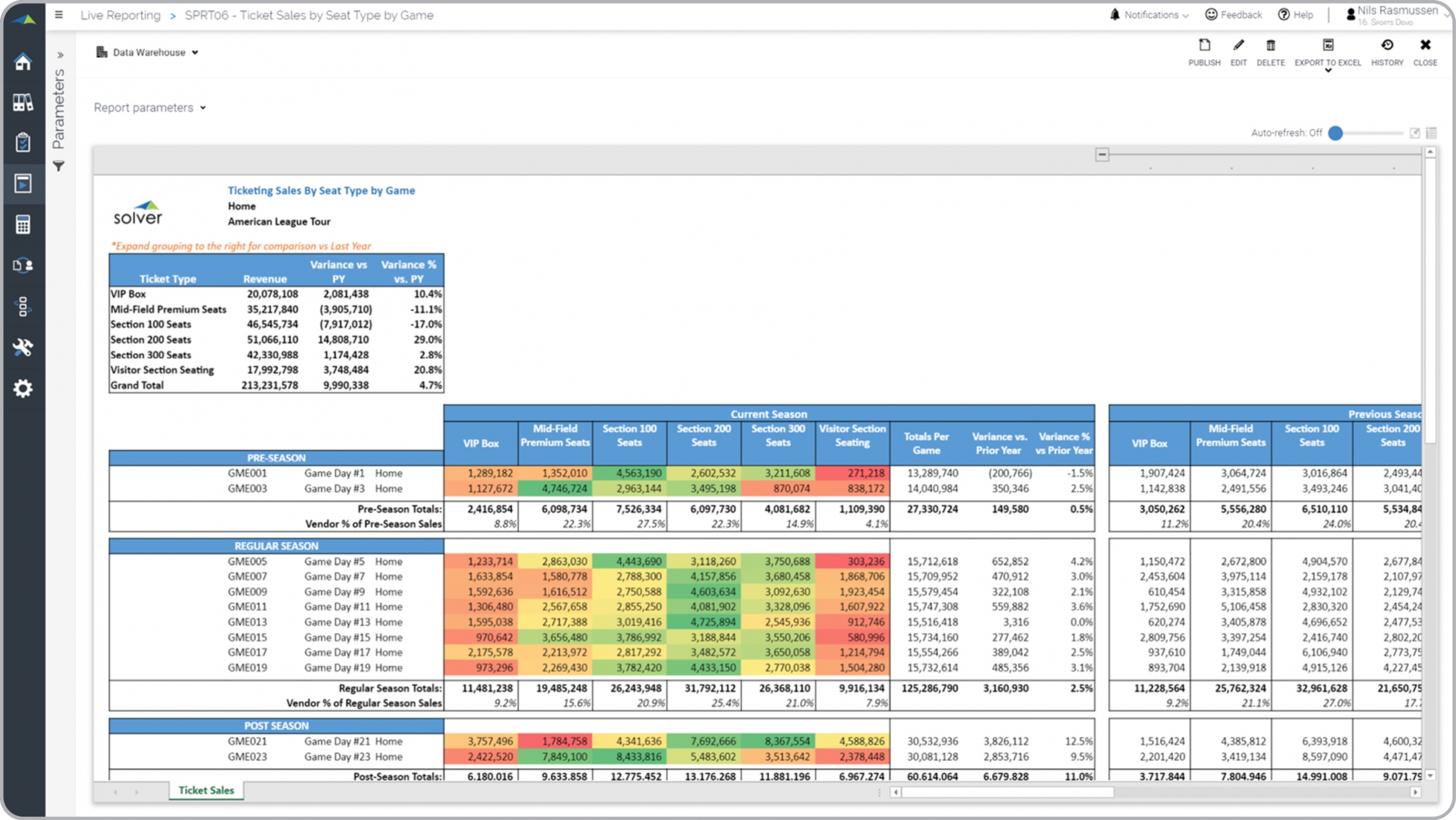Ticket Sales by Seat Type Report for Sports Organizations and Venues
What is a
Ticket Sales by Seat Type Report
? Ticket Sales by Seat Type Reports are considered revenue analysis tools and are used by sales and venue executives and ticket managers to analyze seat revenue metrics. Some of the main functionality in this type of report is that it shows stadium seat revenue parched up into key categories. The report starts with a summary of total revenue by seat category with variances versus prior year. Down the rows, it shows details by game grouped by pre-season, regular season and post season. Seat Types are dynamically listed across the columns. The background colors highlights high (green) and low (red) revenues. You find an example of this type of report below.
Purpose of
Revenue by Seat Type Reports Sports organizations and venues use Revenue by Seat Type Reports to easily monitor how each seat category is performing from a sales perspective. When used as part of good business practices in FP&A and Ticket departments, a company can improve its stadium seating and pricing strategies and increase revenues, and it can reduce the chances that managers don't have the data needed to quickly react to unexpected seat revenue performance.
Example of a
Revenue by Seat Type Report Here is an example of a Revenue by Seat Type Report with detailed sales figures by game and season. [caption id="" align="alignnone" width="2560"]
 Example of a Ticket Sales by Seat Type Report for Sports Organizations and Venues[/caption] You can find hundreds of additional examples
here
Who Uses This Type of
Report
? The typical users of this type of report are: Executives, ticket managers, sales managers, venue managers.
Other Reports Often Used in Conjunction with
Revenue by Seat Type Reports Progressive FP&A and Ticket departments sometimes use several different Revenue by Seat Type Reports, along with detailed ticket by seat type reports, profit & loss reports, sales dashboards, KPI reports, annual budgets and forecasts and other management and control tools.
Where Does the Data for Analysis Originate From? The Actual (historical transactions) data typically comes from enterprise resource planning (ERP) systems like: Microsoft Dynamics 365 (D365) Finance, Microsoft Dynamics 365 Business Central (D365 BC), Microsoft Dynamics AX, Microsoft Dynamics NAV, Microsoft Dynamics GP, Microsoft Dynamics SL, Sage Intacct, Sage 100, Sage 300, Sage 500, Sage X3, SAP Business One, SAP ByDesign, Acumatica, Netsuite and others. In analyses where budgets or forecasts are used, the planning data most often originates from in-house Excel spreadsheet models or from professional corporate performance management (CPM/EPM) solutions.
What Tools are Typically used for Reporting, Planning and Dashboards? Examples of business software used with the data and ERPs mentioned above are:
Example of a Ticket Sales by Seat Type Report for Sports Organizations and Venues[/caption] You can find hundreds of additional examples
here
Who Uses This Type of
Report
? The typical users of this type of report are: Executives, ticket managers, sales managers, venue managers.
Other Reports Often Used in Conjunction with
Revenue by Seat Type Reports Progressive FP&A and Ticket departments sometimes use several different Revenue by Seat Type Reports, along with detailed ticket by seat type reports, profit & loss reports, sales dashboards, KPI reports, annual budgets and forecasts and other management and control tools.
Where Does the Data for Analysis Originate From? The Actual (historical transactions) data typically comes from enterprise resource planning (ERP) systems like: Microsoft Dynamics 365 (D365) Finance, Microsoft Dynamics 365 Business Central (D365 BC), Microsoft Dynamics AX, Microsoft Dynamics NAV, Microsoft Dynamics GP, Microsoft Dynamics SL, Sage Intacct, Sage 100, Sage 300, Sage 500, Sage X3, SAP Business One, SAP ByDesign, Acumatica, Netsuite and others. In analyses where budgets or forecasts are used, the planning data most often originates from in-house Excel spreadsheet models or from professional corporate performance management (CPM/EPM) solutions.
What Tools are Typically used for Reporting, Planning and Dashboards? Examples of business software used with the data and ERPs mentioned above are:
- Native ERP report writers and query tools
- Spreadsheets (for example Microsoft Excel)
- Corporate Performance Management (CPM) tools (for example Solver)
- Dashboards (for example Microsoft Power BI and Tableau)
Corporate Performance Management (CPM) Cloud Solutions and More Examples
June 21, 2021
TAGS:
Reporting,
Solver,
NPSL,
report writer,
Microsoft,
NBA,
template,
practice,
Acumatica,
basketball,
league,
MLB,
Netsuite,
Finance,
planning,
GP,
Business Central,
excel,
professional,
last year,
ax,
Sports,
forecast,
Budget,
Dynamics 365,
budgeting,
professional sports,
Cloud,
Software,
Tableau,
SAP,
NRL,
example,
NHL,
NFL,
best,
Sage,
BC,
EPL,
D365,
MLS,
NAV,
Intacct,
soccer,
hockey,
Variance,
baseball,
CPM,
report,
SL,
Management,
dynamics,
football,
Power BI,
game,
seat type

